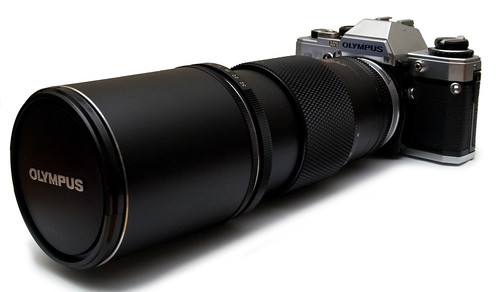Olympus OM system
The Olympus OM is a camera system introduced by Olympus in 1972.
The OM system was designed by Yoshihisa Maitani, who halved the weight of the professional SLR camera body with few compromises in reliability or versatility. The OM-1 has been a favorite of astronomers and others in scientific fields for decades. Its light weight, manual operation and mirror lock-up make it ideal for attaching to telescopes and microscopes. The OM system also became a favorite of all those for whom weight without optical compromises was a primary consideration. OMs have been around the world with some of the National Geographic photographers convinced enough to give up their Canons or Nikons, they have also been to the top of Everest with climber Chris Bonington. Professional photographers David Bailey and Lord Lichfield also used to be associated with the OM system.
The OM system continued to develop with advanced electronics for sophisticated metering systems and program modes, with Olympus being the inventor of off-the-film light metering (on the OM-2), sophisticated TTL flash systems, high-key, low-key and multiple spot metering (on the OM-4) and the invention of high-speed sync flash (on the OM-707). However, when the autofocus revolution hit in the late 80s Olympus was late to the market and with a very unsophisticated non-system camera. Manual focus OMs continued to be sold until the end of the century and they still have a faithful following among enthusiasts today - Olympus have even released an adaptor for the digital Four-Thirds system that allows the use of OM lenses on the new DSLR bodies.
During the design periods, Olympus had studied a completely modular camera, like a 35mm Hasselblad, built in prototype form as the OM-X. You can find some details and pictures here.
Following the failure of the OM System to adapt to the autofocus revolution, Olympus turned its attentions elsewhere - to compact cameras and the IS series of fixed lens SLRs. Recently, Olympus have designed and released a new camera system onto the market: the 'designed for digital' Four-Thirds System.
Contents
Bodies
The very first bodies, launched in 1972, were called M-1. These were later renamed to 'OM-1' following a dispute about the name with Leitz.
We can distinguish two main ranges of manual focus OM bodies:
- the top range OM-1/2/3/4
- the middle range OM-10/20/30/40
The double-digit 'amateur' line of cameras featured smaller, fixed viewfinders, generally slower top shutter speeds, and cheaper components.
Later Olympus introduced two automatic models - the OM-707 and OM-101 which sold poorly, trailed the market somewhat in feature set, and lacked functionality with most of the OM System components.
Still later the OM-2000 was a cheaper body manufactured by Cosina that could accept the OM lenses, but again did not support OM system components, other than most of the lenses.
Availability
The timeline for body releases was as follows:
| Olympus OM Timeline | |||||||||||||||||||||||||||||||
|
Model |
72 | 73 | 74 | 75 | 76 | 77 | 78 | 79 | 80 | 81 | 82 | 83 | 84 | 85 | 86 | 87 | 88 | 89 | 90 | 91 | 92 | 93 | 94 | 95 | 96 | 97 | 98 | 99 | 00 | 01 | 02 |
| OM-1 | |||||||||||||||||||||||||||||||
| OM-2 | |||||||||||||||||||||||||||||||
| OM-10 | |||||||||||||||||||||||||||||||
| OM-3 | |||||||||||||||||||||||||||||||
| OM-20 | |||||||||||||||||||||||||||||||
| OM-30 | |||||||||||||||||||||||||||||||
| OM-4 | |||||||||||||||||||||||||||||||
| OM-2SP | |||||||||||||||||||||||||||||||
| OM-40 | |||||||||||||||||||||||||||||||
| OM-77 | |||||||||||||||||||||||||||||||
| OM-4Ti | |||||||||||||||||||||||||||||||
| OM-88 | |||||||||||||||||||||||||||||||
| OM-3Ti | |||||||||||||||||||||||||||||||
| OM-2000 | |||||||||||||||||||||||||||||||
| Pro (Single-digit) bodies marked in lighter blue. | |||||||||||||||||||||||||||||||
'Pro' Bodies:
- 1972 to 1987 - OM-1 (M-1, OM-1 MD, OM-1n)
- 1978 to 1987 - OM-2 (OM-2n)
- 1984 to 1988 - OM-2SP (OM-2S)
- 1983 to 1986 - OM-3
- 1984 to 1987 - OM-4 (OM-4)
- 1987 to 2002 - OM-4Ti (OM-4T)
- 1995 to 2002 - OM-3Ti
'Amateur' (double-digit) bodies:
- 1978 to 1987 - OM-10,OM-10 QD, OM-10 FC
- 1983 to 1987 - OM-20 (OM-G)
- 1983 to 1987 - OM-30 (OM-F)
- 1985 to 1987 - OM-40 Program (OM-PC)
- 1986 to 1991 - OM-707 (OM-77)
- 1988 to 1991 - OM-101 PF (OM-88)
- 1997 to 2002 - OM-2000
System
The OM system comprised the OM bodies, the OM lenses, and many accessories covering everything from astrophotography to microphotography. For that reason the OM system has been used for many years, and is still used by astro or macro photographers.
Links
- OM Sales information file Huge information about the OM system
- Olympus OM at Modern Classics
- Maitani's fan page, with information about the OM-X
- Professional photographers using the OM, at Maitani's fan page
| Olympus Classic Cameras |
|---|
| Semi | Semi II | Six | Chrome Six | Flex | Standard | 35 | Ace | Pen | Pen F | FTL | OM-1/2/3/4 | OM-10/20/30/40 | Trip | µ (mju:) | XA |
